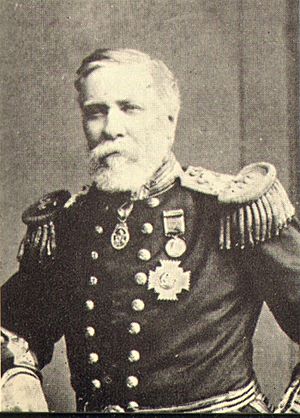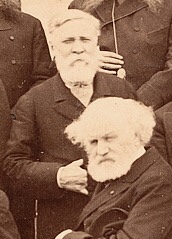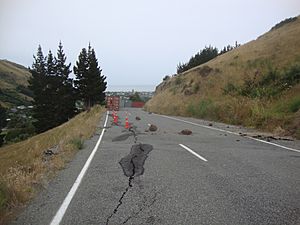Frederick Evans (hydrographer) facts for kids
Quick facts for kids
Sir Frederick Evans
|
|
|---|---|
 |
|
| Born |
Frederick John Owen Evans
9 March 1815 Southsea, Hampshire, England
|
| Died | 20 December 1885 (aged 70) Kensington, London
|
| Occupation | Hydrographer of the Navy |
| Known for | Studies on magnetism |
| Military status | |
| Allegiance | United Kingdom of Great Britain and Ireland |
| Service/ |
|
| Years of service | 1828–1885 |
| Rank | Captain |
| Awards | Knight Commander of the Order of the Bath |
Sir Frederick John Owen Evans (born March 9, 1815 – died December 20, 1885) was an important officer in the Royal Navy. He became a famous hydrographer, which means he was an expert in mapping oceans, seas, and coastlines. He even served as the main Hydrographer for the Navy.
Contents
Life and Adventures of Frederick Evans
Frederick Evans was born in England in 1815. His father was also a master in the Royal Navy. Frederick joined the navy as a volunteer when he was just 13 years old in 1828.
Early Voyages and Surveys
He sailed on several ships, including HMS Rose and HMS Winchester. In 1833, he joined HMS Thunder. For three years, he helped survey the coasts of Central America, the Demerara River, and the Bahama Banks. This means he helped create detailed maps of these areas.
After that, Evans served in the Mediterranean Sea. He sailed on ships like HMS Caledonia and HMS Asia. These early experiences taught him a lot about navigation and mapping.
In 1841, Evans became the master of HMS Fly. For the next five years, he explored and mapped the Coral Sea, the Great Barrier Reef in Australia, and the Torres Strait. Imagine exploring such amazing places! A geologist named Joseph Jukes was also on board and wrote about their journey.
Mapping New Zealand and War Service
After a short time in the Isle of Man, Evans went to New Zealand in 1847 on HMS Acheron. He spent four years mapping the Middle and South Islands of New Zealand. His work was very important for safe navigation in these waters.
During the Crimean War, he served in the Baltic Sea. He was praised for helping to guide the fleet safely through a difficult area called Åland.
Solving the Mystery of Ship Magnetism
Frederick Evans became known for his scientific skills. He was especially good at understanding magnetism. This was a big deal because ships were changing from wood to iron. Iron affects a ship's compass, making it unreliable. Evans realized how important it was to study how magnetic materials in ships messed with compasses.
From 1842 to 1851, he worked hard on this problem. In 1855, he became the head of the navy's compass department. This allowed him to focus completely on how to use magnetic compasses safely on iron ships and armored warships.
Evans worked with another scientist, Archibald Smith, to solve this problem. They did a great job! Evans wrote five important papers about ship magnetism. These were published in a famous science journal called the Philosophical Transactions of the Royal Society. He was even made a member of the Royal Society in 1862.
Becoming the Chief Hydrographer
Evans continued to rise through the ranks. In 1865, he became the Chief Assistant to the main Hydrographer of the Admiralty, Captain George Henry Richards. He also kept leading the magnetic department.
In 1874, Evans took over from Richards and became the Hydrographer of the Navy. He held this important job until 1884. In this role, he was in charge of all the charts, pilot guides, and other publications that the Admiralty produced for sailors.

He received many honors for his work. He was made a Companion of the Order of the Bath in 1873. Later, he was promoted to Knight Commander of the same order in 1881, which meant he could use "Sir" before his name.
He was also a vice-president of the Royal Geographical Society. In 1885, after retiring as Hydrographer, he went to Washington, D.C. He was a delegate at the International Meridian Conference. This meeting helped decide where the prime meridian (the main line of longitude) and a universal day should be.
Sir Frederick Evans passed away in London on December 20, 1885. He was married to Elizabeth Mary Hall.
His Important Publications
Sir Frederick Evans wrote many important books and charts that helped sailors.
Mapping New Zealand and Compass Guides
After his survey work in New Zealand, he and Richards published the 'New Zealand Pilot' in 1856. This book was a guide for ships navigating around New Zealand. It was so useful that it was updated many times.
In 1858, Evans created a special 'Chart of Curves of Equal Magnetic Variation'. This chart helped sailors understand how the Earth's magnetic field changed in different places.
He also wrote a very important 'Report on Compass Deviations in the Royal Navy' in 1860. This report looked at how compasses behaved on different iron ships.
His most famous work was the 'Admiralty Manual for Deviations of the Compass'. He co-edited this with Archibald Smith. This manual became a standard textbook for sailors all over the world. It was even translated into other languages! He also wrote a simpler version called 'Elementary Manual for Deviations of the Compass' in 1870.
Evans also focused a lot on how the Earth's magnetism works. He wrote instructions for scientists on board HMS Challenger in 1872. This ship was on a famous scientific expedition. He also gave a lecture about the 'Magnetism of the Earth' in 1878.
Places Named After Him
Sir Frederick Evans's work was so important that some places are named after him.

While he was surveying in New Zealand, he found a pass that connects the towns of Sumner and Lyttelton. This pass is now called Tapuwaeharuru / Evans Pass.
Nearby, on Banks Peninsula, there is a mountain called Mount Evans, also named in his honor. It is also likely that Evans Head in Kaikiekie / Bradshaw Sound in Fiordland is named after him.
Images for kids
-
Evans (top) and Pierre Janssen at the International Meridian Conference
-
Evans Pass Road below Evans Pass, with damage from the 2011 Christchurch earthquake





